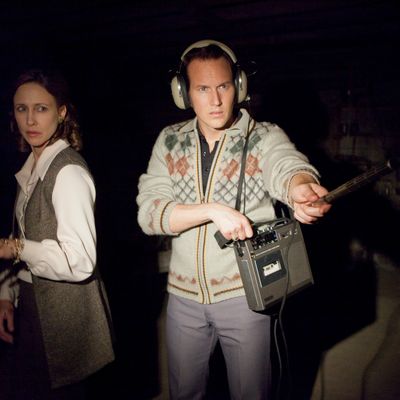
With all due respect to those who believe in the otherworldly, horror films are not real. They are not rooted in reality. They are not inspired by actual events, but are — at best — merely ghost-story versions of the truth. So why, therefore, do they increasingly seem so intent on striving for realism? Be it The Conjuring, which purports to be the true story of a 1971 haunted house–exorcism combo on Rhode Island, or the legion of found-footage efforts that have glutted multiplexes over the past fifteen years, domestic horror cinema has developed something of a “real” problem — namely, doggedly adhering to a false belief that the surest way to scare the bejesus out of audiences is by feigning this-could-happen authenticity. Like the small-screen’s reality-TV infestation, these films have come to dominate the horror landscape, such that even recent standbys like the Saw franchise now seem downright old-school when compared to their Paranormal Activity replacements. And it’s a trend that — exceptions to the rule notwithstanding — is damaging the genre.
Blame it on The Blair Witch Project. Following in the spiritual footsteps of Cannibal Holocaust and its anthropological-fake-out story (and actual animal-slaughter nastiness), Daniel Myrick and Eduardo Sánchez’s seminal 1999 film opened the floodgates on the found-footage tidal wave still sweeping theaters, and with good reason. Playing off the culture’s then-nascent (and now-ubiquitous) obsession with recording anything and everything, it used the novelty first-person POV to such canny effect that millions actually believed it was the recovered video of its three lost-in-the-woods characters. As a one-off stunt, it was brilliant. However, the message it conveyed to filmmakers and audiences alike — that suspense and terror were best delivered via a documentary-filmmaking guise — was far less inspiring, as proven by its legion of successors. Now barely a month goes by without some variation on this device, each one less scary than the last. Generally a collection of jolt scares executed through grainy, limited-perspective tactics, they’re films that strive so hard to seem realistic that they call attention to that very conceit, thus undermining its effectiveness.
This isn’t to say that some found-footage tricks don’t work — the first two Paranormal Activity movies, for example, are expert examples of utilizing POV and its attendant veneer of authenticity to generate unbearable tension. But that doesn’t change the fact that the entire notion of trying to be “realistic” is a fool’s game. It’s difficult enough to make the supernatural believably scary without also requiring it to be actually believable. Thus, when The Last Exorcism or The Haunting in Connecticut strives for realism in both story (this really occurred!) and aesthetics (amateur handheld cinematography!), it’s like a double-whammy of implausibility. Not to mention that such affectations place a greater responsibility on these movies to deliver stories and characters that are more recognizably realistic, at least (in most cases) until their out-of-this-world finales.
Of course, there are many ways to be frightened, none necessarily superior to the rest. But there’s also no doubt that ominous mood, expert pacing, well-crafted storytelling (full of credible character motivations and behavior), and unforgettable imagery trump any spooky pretenses of realism. From The Haunting to Hellraiser, White Zombie to Phantasm, Eraserhead to Jacob’s Ladder, Night of the Hunter to Videodrome, Kwaidan to The Beyond, Possession to Wolf Creek, and The Shining to The Lords of Salem, horror cinema is most evocative and unforgettable when it situates the viewer in an eerily immersive fiction. Lifelike or dreamlike, what matters most is expert filmmaking that sells the fantastical as plausible within the confines of its story’s own, particular fiction. Re-Animator works not because its mad-scientist mayhem could actually happen in real life, but because it seems like — given the setup’s basic ground rules — it could happen in the film.
While this might seem obvious, American horror cinema nonetheless routinely ignores this fundamental fact, seeking credibility either through shaky-cam means or, as with The Conjuring — itself taking a cue from The Amityville Horror — by claiming to have been ripped-from-the-(secret)-headlines. Alas, that latter method is almost always a superfluous addendum that adds nothing, except a sense that the film in question is desperate to legitimize its material in unnecessary ways. When The Texas Chainsaw Massacre’s intro crawl claimed real-life inspiration for its story, it was true in a sense — serial killer Ed Gein was an influence on some of its macabre insanity — and yet, fundamentally, it was a prank, and one that became all the more apparent as Tobe Hooper’s tale plunged headfirst into the sort of ghoulishness specifically reserved for the crazy confines of horror cinema. Leatherface and his cannibalistic clan, like Jason Voorhees, Freddy Krueger, and Jigsaw after them, are terrifying precisely because they’re larger-than-life fiends in the grand — albeit more grittied-up — tradition of Universal’s classic monsters.
If The Silence of the Lambs had claimed that it was based on real events, Hannibal Lecter would have seemed ridiculous. And if that’s true about a procedural’s serial killer, it goes double for out-and-out supernatural sagas, which — whether it’s George A. Romero’s apocalyptic zombie classics, Dario Argento’s lurid, surreal giallos, John Carpenter’s nerve-jangling nightmares, or J-horror’s stringy-haired-girl madness — derive their unique, haunting power from sights of the unreal and the irrational. Admittedly, no genre is more accommodating to different styles, and there’s room for actual events-based efforts to coexist alongside their gory and ethereal brethren. Still, as evidenced by the diminishing returns of innumerable recent faux-verité frightfests, it also remains clear that American horror will once again start truly being scary when it stops being so “real.”

